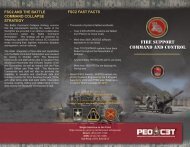2012 Annual Report to the Stakeholders - PEO C3T - U.S. Army
2012 Annual Report to the Stakeholders - PEO C3T - U.S. Army
2012 Annual Report to the Stakeholders - PEO C3T - U.S. Army
Create successful ePaper yourself
Turn your PDF publications into a flip-book with our unique Google optimized e-Paper software.
NIE<br />
13.1 set<br />
for Oc<strong>to</strong>ber-<br />
November<br />
<strong>2012</strong><br />
environment. NIE 12.2 also<br />
accomplished three program<br />
tests for record and evaluated 35<br />
government and industry Systems Under<br />
Evaluation (SUE). The NIE completed <strong>the</strong><br />
Warfighter Information Network-Tactical<br />
(WIN-T) Increment 2 Initial Operational<br />
Test and Evaluation (IOT&E) and marked<br />
significant vehicle integration across <strong>the</strong><br />
BCT, with more than 350 vehicles integrated<br />
with CS 13 baseline systems,<br />
including Infantry BCT, Stryker BCT and<br />
Armored BCT platforms.<br />
“This is really <strong>the</strong> first time that we had<br />
<strong>the</strong> entire BCT kitted out with <strong>the</strong> integrated<br />
network baseline, so it was really<br />
<strong>the</strong> first time across <strong>the</strong> entire formation<br />
we had an operational network and were<br />
conducting missions,” Morrison said.<br />
“And because of that, we’re able <strong>to</strong> now<br />
take a look at that integrated network<br />
baseline and really figure out where we<br />
need <strong>to</strong> tweak <strong>the</strong> architecture <strong>to</strong> enable<br />
mission command.”<br />
The integrated package of radios, sat-<br />
<strong>2012</strong> annual report <strong>to</strong> <strong>the</strong> stakeholders<br />
ellite systems, software applications,<br />
smartphone-like devices and<br />
o<strong>the</strong>r network components supported<br />
2/1 AD as <strong>the</strong> unit spread across <strong>the</strong> desert<br />
and mountains <strong>to</strong> complete its mission.<br />
As Soldiers fought <strong>to</strong> secure <strong>the</strong> fictional<br />
country of Attica, which confronted<br />
an incursion by <strong>the</strong> army of a neighboring<br />
country and an insurgency, <strong>the</strong> network<br />
allowed <strong>the</strong> brigade <strong>to</strong> rapidly pass information<br />
within and across echelons.<br />
Directing <strong>the</strong> fight from Fort Campbell,<br />
Ky., was <strong>the</strong> 101st Airborne Division, acting<br />
as <strong>the</strong> higher headquarters for 2/1<br />
AD. Just as it would in combat operations,<br />
<strong>the</strong> division commanded and coordinated<br />
across subordinate elements, which included<br />
2/1 AD at White Sands, <strong>the</strong> 1st<br />
Sustainment Brigade at Fort Riley, Kan.,<br />
and a “simulation brigade” that was notionally<br />
fighting alongside 2/1 AD <strong>to</strong> provide<br />
added realism and network traffic.<br />
NIE 12.2 was <strong>the</strong> first time <strong>Army</strong><br />
planners incorporated <strong>the</strong> role of higher<br />
headquarters in<strong>to</strong> <strong>the</strong> NIE. Ano<strong>the</strong>r criti-<br />
cal achievement with NIE 12.2 occurred<br />
as <strong>the</strong> <strong>Army</strong> was able <strong>to</strong> employ all early<br />
phases of <strong>the</strong> Agile Process prior <strong>to</strong> <strong>the</strong><br />
NIE start, including using new labora<strong>to</strong>ries<br />
at Aberdeen Proving Ground, Md.,<br />
<strong>to</strong> <strong>the</strong>ir full capability conducting assessments<br />
and mitigating risk prior <strong>to</strong> executing<br />
<strong>the</strong> NIE.<br />
Compared <strong>to</strong> <strong>the</strong> previous two NIEs,<br />
when more troubleshooting occurred in<br />
<strong>the</strong> field, <strong>the</strong> process for 12.2 allowed <strong>the</strong><br />
2nd Brigade, 1st Armored Division (2/1<br />
AD) “<strong>to</strong> run more threads and more execution,<br />
and give <strong>the</strong> <strong>Army</strong> better feedback<br />
on <strong>the</strong> system as a whole,” <strong>the</strong>n- Brigade<br />
Commander Col. Dan Pinnell said.<br />
While <strong>the</strong>re are still elements of <strong>the</strong><br />
network that can be improved, Pinnell<br />
said, giving <strong>the</strong> systems a realistic tryout<br />
has produced valuable information that<br />
<strong>the</strong> <strong>Army</strong> can now act on.<br />
“The Soldier’s voice is coming out now,<br />
finally, directly <strong>to</strong> senior leaders,” he said.<br />
“I’m very happy with <strong>the</strong> quality of feedback<br />
<strong>the</strong> Soldiers are providing.”<br />
We have made<br />
tremendous<br />
strides since we<br />
started <strong>the</strong> NIEs.<br />
Lt. Gen. Bill Phillips,<br />
military deputy <strong>to</strong> <strong>the</strong><br />
Assistant Secretary<br />
of <strong>the</strong> <strong>Army</strong> for<br />
Acquisition, Logistics<br />
and Technology<br />
Program ExEcutivE officE command control communications-tactical // 5



